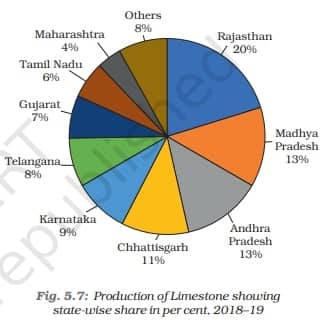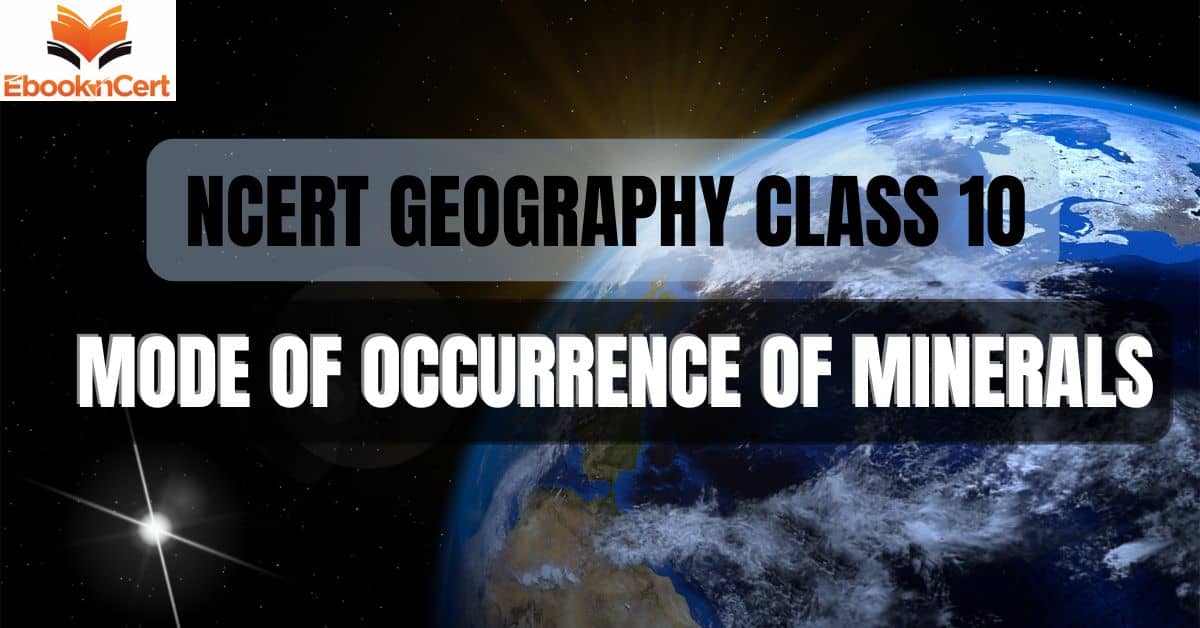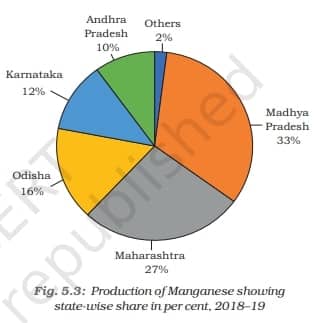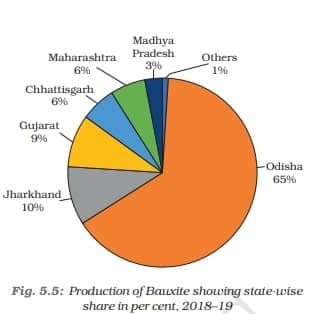NCERT Geography Class 10 | Mode Of Occurrence Of Minerals
Topic & sub-topics covered: Mode Of Occurrence Of Minerals and MCQs Questions: Minerals and Energy Resources (All single detail notes are exam-oriented).
We have discussed in-depth and exam-oriented pointers that can be asked in the board exam of class 10th about “Mode Of Occurrence Of Minerals” from the NCERT Geography notes for class 10th chapter 5th “Minerals and Energy Resources“.
Download the NCERT Geography for Class 10th Chapter 5 Minerals and Energy Resources PDF Notes
NCERT Geography Class 10th Chapter 5 – Minerals and Energy Resources
Complete your Geography preparation for your board exam or any examinations for NCERT Geography Class 10 Chapter 5: Minerals and Energy Resources PDF Notes! This chapter dives deep into the types, distribution, and uses of various minerals and energy resources, the Occurrence Of Minerals, and the Conservation Of Minerals that are essential for human development. With explanations that are easy to understand for any student and key points highlighted, these notes are ideal for exam preparation and quick revisions. Simplify your study process with this comprehensive resource. Download the PDF now and stay ahead in your Class 10 Geography journey!
Mode Of Occurrence Of Minerals
1. Minerals and Ores:
- Minerals are typically found in ores, mineral accumulations mixed with other elements.
- Ore extraction is viable only if the mineral content is sufficiently concentrated.
- The ease of mining and the cost of extraction depends on the type of formation where the minerals occur.
2. Forms in Which Minerals Occur:
- Igneous and Metamorphic Rocks:
a. Found in cracks, crevices, faults, and joints.
b. Smaller deposits: Veins; larger deposits: Lodes.
c. Examples: Tin, copper, zinc, and lead. - Sedimentary Rocks:
a. Found in beds or layers.
b. Examples: Coal, iron ore (formed under heat and pressure), gypsum, potash salt, and sodium salt (formed due to evaporation in arid regions). - Residual Material:
a. Formed by the decomposition of surface rocks and removal of soluble constituents.
b. Example: Bauxite. - Placer Deposits:
a. Found in sands of valley floors or hill bases.
b. Example: Gold, silver, tin, and platinum (non-corroding minerals). - Ocean Sources:
a. Ocean waters: Contain minerals like common salt, magnesium, and bromine.
b. Ocean beds: Rich in manganese nodules.
3. Mining in India:
- Rat-hole mining in Meghalaya:
a. Involves narrow tunnels dug by individuals or families.
b. Declared illegal by the National Green Tribunal due to environmental and health hazards.
4. Distribution of Minerals in India:

- Peninsular Rocks: Rich in coal, metallic minerals, mica, and non-metallic minerals.
- Sedimentary Rocks: Found in Gujarat and Assam; they contain petroleum deposits.
- Alluvial Plains of North India: Almost devoid of economic minerals.
- Rajasthan: Rich in non-ferrous minerals due to its geological structure.
5. Ferrous Minerals:
- Iron Ore:
a. The backbone of industrial development.
b. Magnetite: High iron content (~70%), used in the electrical industry.
c. Hematite: Major industrial use; slightly lower iron content (50–60%).
d. Major iron ore belts:
I. Odisha-Jharkhand: Badampahar, Gua, Noamundi.
II. Durg-Bastar-Chandrapur: Bailadila range; high-grade ore exported to Japan and South Korea.
III. Ballari-Chitradurga-Tumakuru: Kudremukh mines export ore as slurry.
IV. Maharashtra-Goa: Marmagao port exports ore. - Manganese:

Source: NCERT Book a. Used in steel manufacturing, bleaching powder, insecticides, and paints.
b. 10 kg of manganese needed for 1 tonne of steel.
6. Non-Ferrous Minerals:
- Copper:
a. Used in electrical cables, electronics, and chemical industries.
b. Major mines: Balaghat (Madhya Pradesh), Khetri (Rajasthan), Singhbhum (Jharkhand). - Bauxite:

Source: NCERT Book a. Source of aluminium, known for its lightness and conductivity.
b. Major deposits: Amarkantak plateau, Maikal hills, Bilaspur-Katni plateau (Odisha leads production).
7. Non-Metallic Minerals:

- Mica:
a. Found in thin sheets; excellent insulating properties.
b. Major deposits: Chota Nagpur plateau (Jharkhand), Ajmer (Rajasthan), Nellore (Andhra Pradesh). - Limestone:
a. Used in the cement industry and smelting iron ore.
b. Found in sedimentary rock formations.
8. Environmental and Health Hazards of Mining:
- Health Risks:
a. Dust and fumes cause pulmonary diseases.
b. Risks of collapsing roofs, inundation, and coal mine fires. - Environmental Degradation:
a. Contamination of water sources.
b. Land and soil degradation due to waste dumping.
c. Stream and river pollution from slurry. - Regulations Needed:
a. Stricter safety and environmental laws are essential.
Key Terms and Facts:
- Veins and Lodes: Smaller and larger mineral deposits in igneous/metamorphic rocks.
- Rat-hole Mining: Illegal coal mining in Meghalaya.
- Kudremukh: Largest iron ore deposits, 100% export unit in Karnataka.
- Bailadila Range: High-grade iron ore with excellent steel-making properties.
- Chota Nagpur Plateau: Known as the “storehouse of minerals” in India.
FAQ’s
Question 1. What is the difference between open-pit mining, quarries, and underground mining?
Answer:
- Open-pit mining involves extracting minerals from a large, open excavation on the surface.
- Quarries are open-pit mines specifically used for extracting building materials like stones and sand.
- Underground mining uses shafts and tunnels to extract minerals deep below the earth’s surface.
Question 2. Why is Chota Nagpur considered a storehouse of minerals?
Answer:
- Chota Nagpur Plateau is rich in metallic minerals like iron ore, manganese, and mica, along with non-metallic minerals like limestone.
- Its unique geological structure, including igneous and metamorphic rocks, contributes to its abundant mineral resources.
Question 3. How are iron ore, manganese, and coal linked to the iron and steel industry?
Answer:
- Iron ore is the primary raw material for steel production.
- Manganese is essential for making steel, as 10 kg of manganese is required per tonne of steel.
- Coal is used as a fuel and reducing agent in smelting iron ore to produce steel.
Question 4. Where are these minerals found?
Answer: Minerals are usually found in ores, accumulations of minerals mixed with other elements. The concentration of the mineral in the ore must be sufficient to make its extraction commercially viable. The ease and cost of mining mineral ores depend on the type of geological formation or structure in which they are found. Understanding these formations is essential for efficient extraction.
Next & Previous Topics of NCERT/CBSE Geography Class 10 Chapter 5: Minerals and Energy Resources
| Topics No. | Topics Name |
|---|---|
| 1 | Introduction To Minerals and Energy Resources |
| 2 | Mode of Occurrence of Minerals |
| 3 | Conservation of Minerals |
MCQ Questions on NCERT Geography Class 10 Chapter 5 | Mode Of Occurrence Of Minerals
Question 1. What is an ore?
A. A single pure mineral
B. A naturally occurring solid with no economic use
C. An accumulation of minerals mixed with other elements
D. A material used for construction
Answer: C. An accumulation of minerals mixed with other elements
Question 2. What are the smaller mineral occurrences in igneous and metamorphic rocks called?
A. Lodes
B. Veins
C. Placer deposits
D. Residual deposits
Answer: B. Veins
Question 3. Which mineral is commonly obtained from veins and lodes?
A. Coal
B. Tin
C. Sodium salt
D. Bauxite
Answer: B. Tin
Question 4. How are minerals like gypsum and sodium salt formed in sedimentary rocks?
A. Deposition in horizontal strata
B. Cooling of molten materials
C. Evaporation in arid regions
D. Decomposition of surface rocks
Answer: C. Evaporation in arid regions
Question 5. Which process forms bauxite deposits?
A. Sedimentation
B. Decomposition of surface rocks and removal of soluble constituents
C. Evaporation in arid regions
D. Solidification of molten minerals
Answer: B. Decomposition of surface rocks and removal of soluble constituents
Question 6. What are placer deposits?
A. Minerals found in ocean water
B. Deposits found in cracks and crevices
C. Alluvial deposits in valley floors and hill bases
D. Minerals formed under high heat and pressure
Answer: C. Alluvial deposits in valley floors and hill bases
Question 7. Which mineral is NOT typically found in placer deposits?
A. Gold
B. Silver
C. Platinum
D. Hematite
Answer: D. Hematite
Question 8. Which mineral is largely derived from ocean waters?
A. Manganese
B. Bromine
C. Bauxite
D. Copper
Answer: B. Bromine
Question 9. Which type of rock contains most of India’s coal and metallic minerals?
A. Sedimentary rocks
B. Igneous rocks
C. Peninsular rocks
D. Alluvial rocks
Answer: C. Peninsular rocks
Question 10. Where are India’s petroleum deposits primarily located?
A. Chota Nagpur Plateau
B. Gujarat and Assam
C. Rajasthan
D. Odisha and Jharkhand
Answer: B. Gujarat and Assam
Question 11. Which region in India has the least economic minerals?
A. Peninsular region
B. Western coastal plains
C. Alluvial plains of North India
D. Chota Nagpur Plateau
Answer: C. Alluvial plains of North India
Question 12. Which state has the highest production of bauxite in India?
A. Madhya Pradesh
B. Odisha
C. Rajasthan
D. Karnataka
Answer: B. Odisha
Question 13. The Kudremukh mines in Karnataka are known for which mineral?
A. Manganese
B. Copper
C. Iron Ore
D. Limestone
Answer: C. Iron Ore
Question 14. Which type of iron ore has the highest iron content?
A. Hematite
B. Magnetite
C. Limonite
D. Siderite
Answer: B. Magnetite
Question 15. Which mineral is essential in the production of steel?
A. Bauxite
B. Manganese
C. Copper
D. Gold
Answer: B. Manganese
Question 16. Which mineral is primarily used in electrical cables?
A. Copper
B. Iron
C. Aluminium
D. Mica
Answer: A. Copper
Question 17. Which mineral is the basic raw material for cement production?
A. Mica
B. Limestone
C. Bauxite
D. Magnetite
Answer: B. Limestone
Question 18. Which region in India is called the storehouse of minerals?
A. Chota Nagpur Plateau
B. Deccan Plateau
C. Himalayan Region
D. Indo-Gangetic Plains
Answer: A. Chota Nagpur Plateau
Question 19. What is ‘Rat-Hole Mining’?
A. Open-pit mining technique
B. Illegal mining using narrow tunnels in tribal areas
C. Quarrying for non-metallic minerals
D. Mining in ocean beds
Answer: B. Illegal mining using narrow tunnels in tribal areas
Question 20. What is the main health hazard for miners?
A. Physical injuries from machinery
B. Pulmonary diseases due to dust and fumes
C. Poor nutrition
D. Inadequate ventilation
Answer: B. Pulmonary diseases due to dust and fumes
Question 21. What environmental issue is caused by mining waste?
A. Increased vegetation
B. Degradation of land and river pollution
C. Lowering water table
D. Formation of new minerals
Answer: B. Degradation of land and river pollution
Question 22. Which mineral is used in electrical industries for its insulating properties?
A. Mica
B. Copper
C. Bauxite
D. Magnetite
Answer: A. Mica
Question 23. What determines the economic viability of a mineral reserve?
A. The colour of the mineral
B. Its proximity to cultural heritage sites
C. The concentration of minerals in the ore and ease of extraction
D. The geological age of the mineral
Answer: C. The concentration of minerals in the ore and ease of extraction



